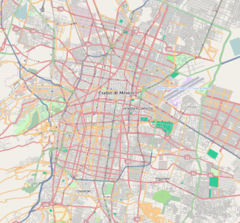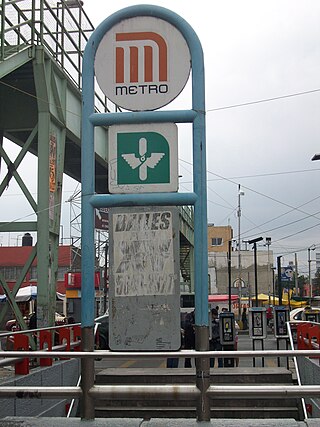
Escuadrón 201 is a metro station in Mexico City, Mexico. It is located in the city's eastern Iztapalapa borough, close to the intersection of Eje 3 Oriente and Eje 8 Sur.

Tasqueña is a station on Line 2 of the Mexico City Metro system. It is located in the Campestre Churubusco neighborhood, within the Coyoacán borough of Mexico City, directly south of the city centre on Avenida Tasqueña and Canal de Miramontes. It is a surface station and the southern terminus of the line. In 2019, the station had an average ridership of 83,463 passengers per day, making it the seventh busiest station in the network.
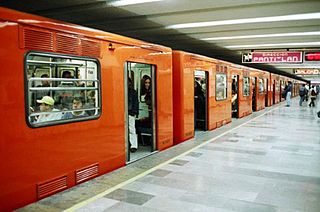
Merced is an underground station on Line 1 of the Mexico City Metro. It is located in the Venustiano Carranza borough, slightly to the east of the centre of Mexico City. The station building was designed by Félix Candela, and it was opened on 4 September 1969. From July 2022 to October 2023, the station was closed due to modernization works on the tunnel and the line's technical equipment.

Martín Carrera is a station on the Mexico City Metro. It is located at the borders of the Colonia Martín Carrera, Colonia 15 de Agosto, and Colonia Díaz Mirón districts in the Gustavo A. Madero borough, in the north of Mexico City. The station logo depicts bust of General Martín Carrera, a national hero who fought in the Mexican–American War of 1846–48.

Copilco is a station along Line 3 on the Mexico City Metro. Located in the Coyoacán borough, in the south of Mexico City, on Avenida Enríquez Ureña. It is the penultimate station along the southern portion of Line 3.

Ermita is a station on Line 2 and Line 12 of the Mexico City Metro system. According to the Sistema de Transporte Colectivo, Ermita serves as a transfer station of Line 12. It is located in the Benito Juárez borough of Mexico City, directly south of the city centre on Calzada de Tlalpan.
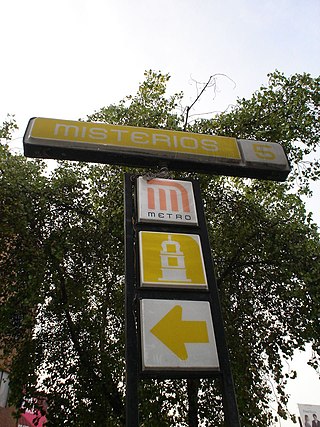
Misterios metro station is a Mexico City Metro station within the limits of Cuauhtémoc and Gustavo A. Madero, in Mexico City. It is an underground station with two side platforms, served by Line 5, between La Raza and Valle Gómez stations. Misterios station serves the colonias (neighborhoods) of Peralvillo and Vallejo.
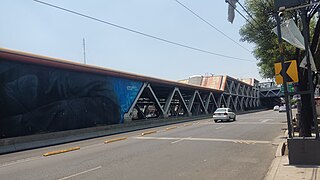
Aculco is a station along Line 8 of the metro of Mexico City. It is located under the bridge where the Trabajadoras Sociales passes over the Eje 3 Ote in the Colonia Pueblo Aculco neighborhood of the Iztapalapa borough of Mexico City. The station's logo is a water wave in a canal. In Nahuatl it means "where the water twists". The name is also the name of the Aculco municipality in the State of Mexico.

Atlalilco is a station along Line 8 and Line 12 of the metro of Mexico City. Atlalilco is a transfer station between the Line 12 and Line 8. Line 8 station is located on the Calzada Ermita Iztapalapa, while Line 12 station is located on Avenida Tláhuac, in the Colonia Santa Isabel Industrial neighbourhood.
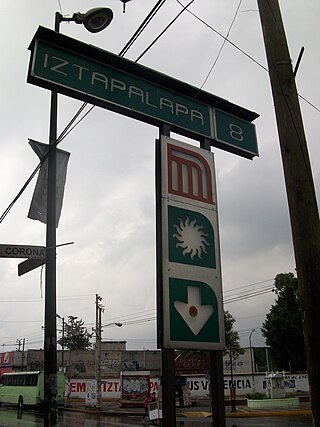
Iztapalapa is a station along Line 8 of the metro of Mexico City. It is located on the Calzada Ermita Iztapalapa in the Colonia El Santuario neighborhood of Iztapalapa borough on the southeast side of the city.
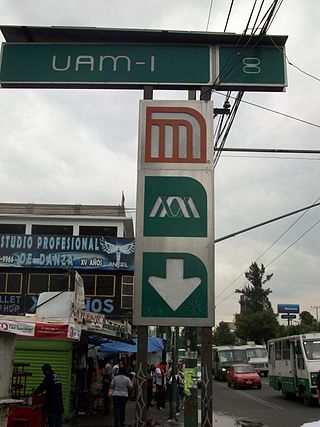
UAM-I is a station along Line 8 of the Mexico City Metro.
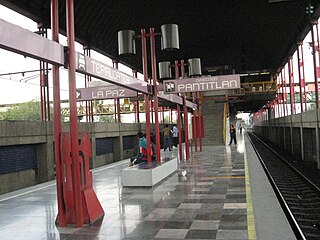
Tepalcates is a station on the Line A of the Mexico City Metro. It is located in the Iztapalapa municipality, to the east of downtown Mexico City. In 2019, the station had an average ridership of 19,326 passengers per day.

Guelatao metro station is a Mexico City Metro station in the Iztapalapa borough of Mexico City. It is an at-grade station that serves Line A between Tepalcates and Peñón Viejo stations.
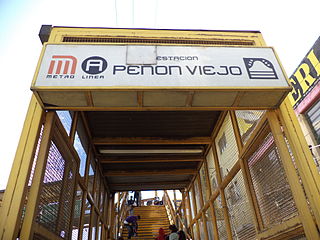
Peñon Viejo is a station along Line A of the Mexico City Metro. It is located in the Colonia Santa Martha Acatitla Norte and Colonia Santa Martha Acatitla Sur neighborhoods of the Iztapalapa borough of Mexico City.
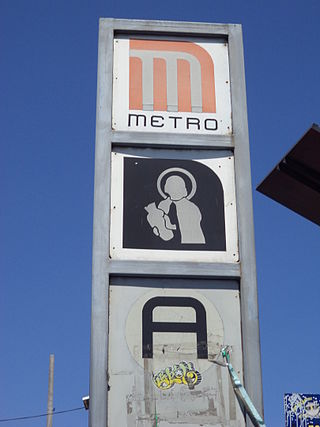
Santa Marta is a station along Line A of the Mexico City Metro. It is located in the Colonia Ermita Zaragoza neighborhood of the Iztapalapa borough in Mexico City.
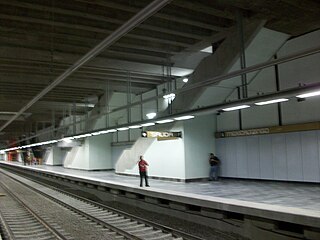
Mexicaltzingo is a station on Line 12 of the Mexico City Metro. The station is located between Ermita and Atlalilco. It was opened on 30 October 2012 as a part of the first stretch of Line 12 between Mixcoac and Tláhuac.

Culhuacán is a station on Line 12 of the Mexico City Metro. The station is located between Atlalilco and San Andrés Tomatlán. It was opened on 30 October 2012 as a part of the first stretch of Line 12 between Mixcoac and Tláhuac.

San Andrés Tomatlán is a station on Line 12 of the Mexico City Metro. The station is located between Culhuacán and Lomas Estrella. It was opened on 30 October 2012 as a part of the first stretch of Line 12 between Mixcoac and Tláhuac.

Lomas Estrella is a station on Line 12 of the Mexico City Metro. The station is located between San Andrés Tomatlán and Calle 11. It was opened on 30 October 2012 as a part of the first stretch of Line 12 between Mixcoac and Tláhuac.

Calle 11 is a station on Line 12 of the Mexico City Metro. The station is located between Lomas Estrella and Periférico Oriente. It was opened on 30 October 2012 as a part of the first stretch of Line 12 between Mixcoac and Tláhuac.

